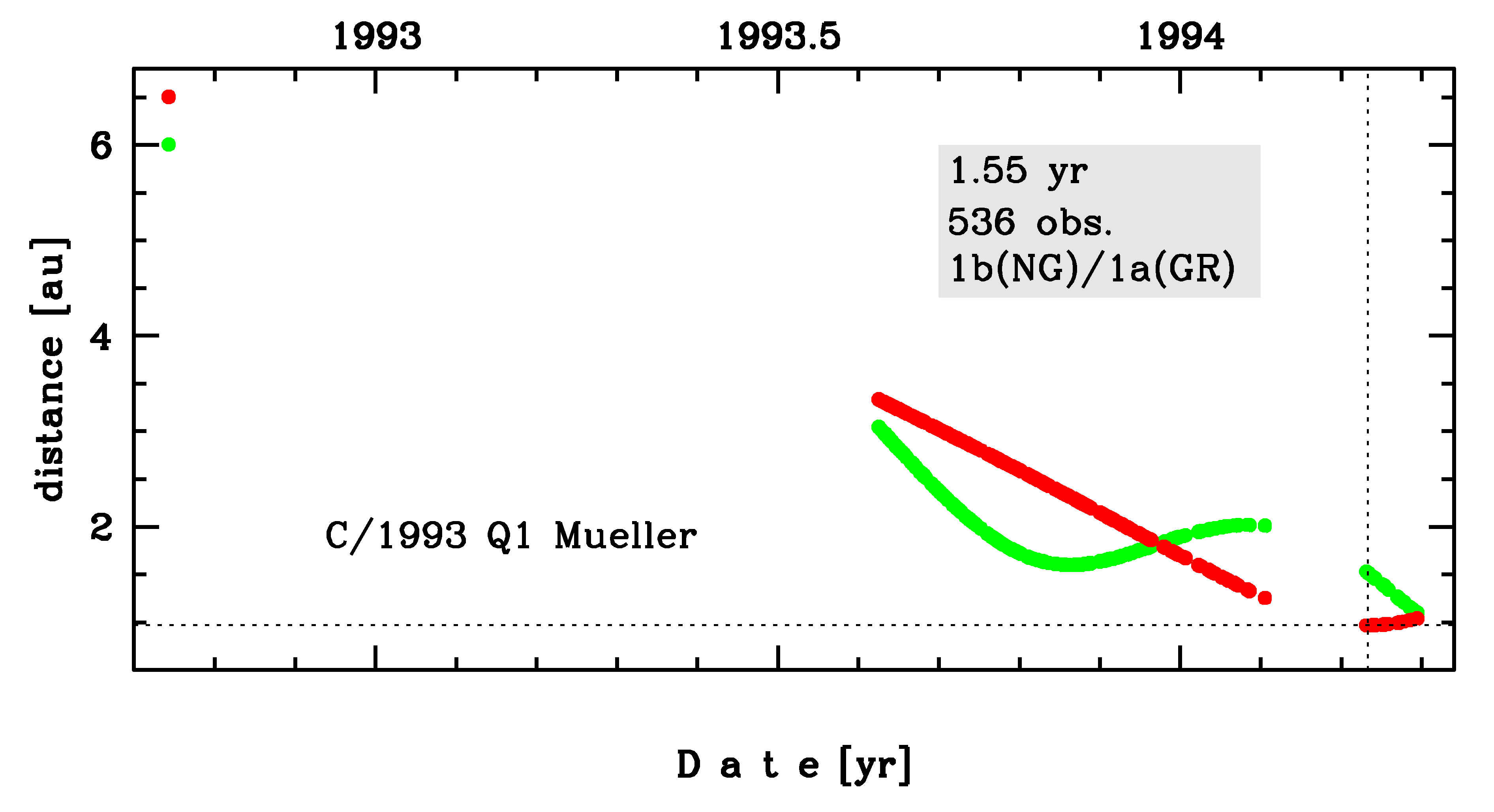C/1993 Q1 Mueller
more info
Comet C/1993 Q1 was discovered on 16 August 1993 by Jean Mueller (Palomar Sky Survey II). Later, a prediscovery image of this comet taken on 28 September 1992 (Palomar Mountain-DSS) was found. At the moment of discovery, this comet was about 7.5 months before its perihelion passage and it was last observed in the mid-April 1994.
Comet had its closest approach to the Earth on 7 May 1994 (0.899 au), 1.5 month after its perihelion passage.
Preferred solution given here is based on data spanning over 1.55 yr in a range of heliocentric distances: 6.51 au – 0.967 au (perihelion) – 1.04 au.
Sekanina (2019) speculates that this comet may not have survived the perihelion passage.
This Oort spike comet suffers small planetary perturbations during its passage through the planetary system; if C/1993 Q1 survived the perihelion passage these perturbations lead to escape the comet on hyperbolic orbit from the planetary zone.
See also Królikowska 2020. .
Comet had its closest approach to the Earth on 7 May 1994 (0.899 au), 1.5 month after its perihelion passage.
Preferred solution given here is based on data spanning over 1.55 yr in a range of heliocentric distances: 6.51 au – 0.967 au (perihelion) – 1.04 au.
Sekanina (2019) speculates that this comet may not have survived the perihelion passage.
This Oort spike comet suffers small planetary perturbations during its passage through the planetary system; if C/1993 Q1 survived the perihelion passage these perturbations lead to escape the comet on hyperbolic orbit from the planetary zone.
See also Królikowska 2020. .
| solution description | ||
|---|---|---|
| number of observations | 536 | |
| data interval | 1992 09 28 – 1994 04 17 | |
| data type | almost all measurements before perihelion (PRE++) | |
| data arc selection | entire data set (STD) | |
| range of heliocentric distances | 6.51 au – 0.97 au (perihelion) – 1.04 au | |
| detectability of NG effects in the comet's motion | comet with determinable NG~orbit | |
| type of model of motion | GR - gravitational orbit | |
| data weighting | YES | |
| number of residuals | 1066 | |
| RMS [arcseconds] | 1.00 | |
| orbit quality class | 1a | |
| previous orbit statistics, both Galactic and stellar perturbations were taken into account | ||
|---|---|---|
| no. of returning VCs in the swarm | 0 | |
| no. of escaping VCs in the swarm | 5001 | * |
| no. of hyperbolas among escaping VCs in the swarm | 1329 | |
| previous reciprocal semi-major axis [10-6 au-1] | -1.46 – 1.42 – 4.26 | |
| previous perihelion distance [au] | 1270 – 1350 – 1420 | |
| previous aphelion distance [103 au] | 430 – 920 – 4400 | |
| time interval to previous perihelion [Myr] | 3.02 ± 6.3 | |
| percentage of VCs with qprev > 20 | 100 | |
| previous_g orbit statistics, here only the Galactic tide has been included | ||
|---|---|---|
| no. of returning VCs in the swarm | 0 | |
| no. of escaping VCs in the swarm | 5001 | * |
| no. of hyperbolas among escaping VCs in the swarm | 4 | |
| previous reciprocal semi-major axis [10-6 au-1] | 3.80 – 6.38 – 8.93 | |
| previous perihelion distance [au] | 16 – 18 – 21 | |
| previous aphelion distance [103 au] | 220 – 310 – 530 | |
| time interval to previous perihelion [Myr] | 3.21 ± 6.3 | |
| percentage of VCs with 10 < qprev < 20 | 78 | |
| percentage of VCs with qprev > 20 | 22 | |
